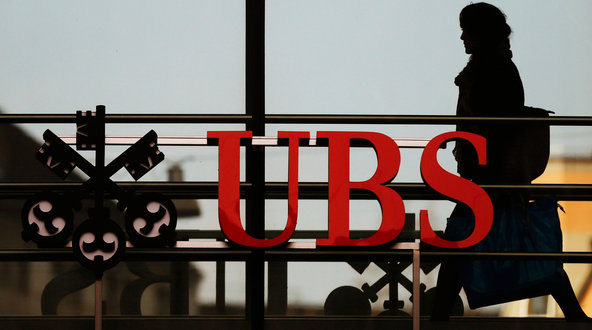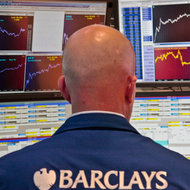 Michael Buholzer/ReutersUBS accepted a $1.5 billion fine for its role in manipulating interest rates.
Michael Buholzer/ReutersUBS accepted a $1.5 billion fine for its role in manipulating interest rates.
UBS on Wednesday became the first big global bank in more than two decades to have a subsidiary plead guilty to fraud.
UBS, the Swiss bank, scrambled until the last minute to avoid that fate. A week ago, in a bid for leniency over interest-rate manipulation, the bank’s chairman traveled to Washington to plead his case to the Justice Department, according to people briefed on the matter. Knowing the long odds, the chairman, Axel Weber, asked the criminal division for a lighter punishment.
But the government did not budge. With support from Attorney General Eric H. Holder Jr., the agency’s criminal division decided the bank’s actions were simply too egregious, people briefed on the matter said.
Related Links
On Wednesday, UBS announced it would plead guilty to one count of felony wire fraud as part of a broader settlement. With federal prosecutors, British, Swiss and American regulators secured about $1.5 billion in fines, more than triple the only other rate-rigging case, against Barclays. The Justice Department also filed criminal charges against two former UBS traders.
The guilty plea and the individual charges provide the Justice Department with a long-awaited case to prove it is taking a hard line against financial wrongdoing.
Since the financial crisis, the government has faced criticism that it has not brought significant criminal actions. The money-laundering case against HSBC, which averted indictment when it agreed instead last week to pay $1.9 billion, raised more concerns that the world’s largest and most interconnected banks were too big to indict.
With UBS, prosecutors wanted to send a warning.
The Justice Department’s decision stops short of imperiling the broader financial system because it shields UBS’s parent company from losing its charter, among other major repercussions. But by securing a guilty plea against a subsidiary, the department has shown that it is willing to punish severely one of the world’s most powerful banks. It was the first guilty plea from a major financial institution since Drexel Burnham Lambert admitted to six counts of fraud in 1989.
“We are holding those who did wrong accountable,” Lanny A. Breuer, the head of the Justice Department’s criminal division, said at a news conference on Wednesday. “We cannot, and we will not, tolerate misconduct on Wall Street.”
The rate-rigging inquiry, which has ensnared more than a dozen big banks, is focused on major benchmarks like the London interbank offered rate, or Libor. Such rates are central to determining the borrowing rates for trillions of dollars of financial products like corporate loans, mortgages and credit cards.
The fallout from the UBS case is expected to increase pressure on some of the world’s largest financial institutions and spur settlement talks across the banking industry. The Royal Bank of Scotland has said it expects to pay fines before its next earnings statement in February, while American institutions, including JPMorgan Chase, also remain in regulators’ cross hairs.
The UBS case highlighted a pattern of abuse that authorities have uncovered in a multiyear investigation into the rate-setting process. The government complaints laid bare a 10-year scheme, describing how the bank had reported false rates to squeeze out extra profits and deflect concerns about its health during the financial crisis.
“The settlement reflects the magnitude of the wrongdoing and how critical it is that these be honest and reliable,” said Gary S. Gensler, chairman of the Commodity Futures Trading Commission, the American regulator that opened the UBS investigation.
Six months ago, authorities did not seem ready to take an aggressive stance with UBS.
They had just scored their first Libor settlement, a $450 million payout from Barclays. UBS, which had already struck a conditional immunity deal with the Justice Department’s antitrust division, figured its penalty would be similar.
The immunity deal, some UBS executives contended, would protect the bank from criminal charges. Even officials at the Justice Department were skeptical about the prospect of levying large penalties, according to people briefed on the matter.
Then the tone shifted this fall. After examining thousands of e-mails and hours of taped phone calls, the agency’s criminal division concluded that the conduct at the Japanese subsidiary warranted a criminal charge.
Agency officials also cited the bank’s repeated run-ins with authorities. For example, the Swiss bank had agreed in 2009 to pay $780 million to settle charges that it had helped clients avoid taxes.
Not everyone in the Justice Department agreed on the course of action. According to people briefed on the matter, the antitrust unit pushed for less-onerous penalties, citing the cooperation of UBS. With officials split over how to proceed, Mr. Holder cast the deciding vote in favor of securing a guilty plea from the subsidiary.
The move caught UBS off guard. The bank dispatched dozens of lawyers to Washington to negotiate the fine print of the deal, setting up makeshift offices at the Four Seasons hotel in Georgetown.
Mr. Weber joined the lawyers, in a typical last-ditch appeal to the criminal division. Last Wednesday, Mr. Weber and his general counsel explained to the agency how UBS had overhauled its management ranks, bolstered internal controls and generally tried to clean up its act.
Mr. Breuer and other Justice Department officials agreed to consider the bank’s request to abandon the guilty plea, people briefed on the talks said. But hours later, a prosecutor phoned to say the agency was standing firm.
UBS agreed to the guilty plea, conceding that the Japanese unit would otherwise most likely face an indictment. In turn, prosecutors credited the bank for its recent efforts to improve.
“We are pleased that the authorities gave us credit for the important and positive changes we have already made,” Mr. Weber said in a statement.
The Commodity Futures Trading Commission adopted a similarly tough attitude.
Since Thanksgiving, UBS has tried to negotiate lower penalties with the regulator, according to people briefed on the matter. But David Meister, the agency’s enforcement chief, would not back down from $700 million in fines, an agency record.
“Even for a megabank, that amount serves as a direct deterrent,” said Bart Chilton, a commissioner at the regulator.
Authorities’ strict stance stems from the extent of the bank’s actions. The Commodity Futures Trading Commission cited more than 2,000 instances of illegal acts involving dozens of UBS employees across continents.
The most significant wrongdoing took place within the Japanese unit, where traders colluded with other banks and brokerage firms to tinker with yen-denominated Libor and bolster their returns.
In colorful e-mails, instant messages and phone calls, traders tried to influence the rates. “I need you to keep it as low as possible,” one UBS trader said to an employee at another brokerage firm, according to the complaint filed by the Financial Services Authority of Britain.
As the employees carried out the ostensible manipulation, they also celebrated the efforts, with one trader referring to a partner in the scheme as “superman.” “Be a hero today,” he urged, according the complaint.
The Justice Department also took aim at two former UBS traders, Tom Hayes, 33, and Roger Darin, 41, bringing the first criminal charges against individuals connected to the Libor case.
Like other traders at UBS, Mr. Hayes was willing to reward others for their efforts. He trumpeted the work of an outside broker who had helped, writing in a message, “i reckon i owe him a lot more.” Another broker responded that the person was “ok with an annual champagne shipment,” and “a small bonus every now and then.”
As prosecutors ramped up their investigation, Mr. Hayes even tried to dissuade former colleagues from cooperating, the complaint said. “The U.S. Department of Justice, mate, you know,” he said, they are the “dudes who…put people in jail. Why…would you talk to them?”
Mark Scott, Ashley Southall and Julia Werdigier contributed reporting.
Article source: http://dealbook.nytimes.com/2012/12/19/leniency-denied-ubs-unit-admits-guilt-in-rate-case/?partner=rss&emc=rss
